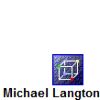| |
    
Katharina Huber,
Michael Langton,
David Penny,
Vincent Moulton and
Mike Hendy. Spectronet: A package for computing spectra and median networks. In ABIO, Vol. 1(3):159-161, 2004.
Keywords: from splits, median network, phylogenetic network, phylogeny, Program Spectronet, software, split, visualization.
Note: http://citeseer.ist.psu.edu/631776.html.
Toggle abstract
Spectronet is a package that uses various methods for exploring and visualising complex evolutionary signals. Given an alignment in NEXUS format, the package works by computing a collection of weighted splits or bipartitions of the taxa and then allows the user to interactively analyse the resulting collection using tools such as Lento-plots and median networks. The package is highly interactive and available for PCs.
|
|
| |
 
Katharina Huber,
Elizabeth E. Watson and
Mike Hendy. An Algorithm for Constructing Local Regions in a Phylogenetic Network. In MPE, Vol. 19(1):1-8, 2000.
Keywords: abstract network, median network, phylogenetic network, phylogeny, reconstruction, split.
Note: http://dx.doi.org/10.1006/mpev.2000.0891.
Toggle abstract
"The groupings of taxa in a phylogenetic tree cannot represent all the conflicting signals that usually occur among site patterns in aligned homologous genetic sequences. Hence a tree-building program must compromise by reporting a subset of the patterns, using some discriminatory criterion. Thus, in the worst case, out of possibly a large number of equally good trees, only an arbitrarily chosen tree might be reported by the tree-building program as" The Tree." This tree might then be used as a basis for phylogenetic conclusions. One strategy to represent conflicting patterns in the data is to construct a network. The Buneman graph is a theoretically very attractive example of such a network. In particular, a characterization for when this network will be a tree is known. Also the Buneman graph contains each of the most parsimonious trees indicated by the data. In this paper we describe a new method for constructing the Buneman graph that can be used for a generalization of Hadamard conjugation to networks. This new method differs from previous methods by allowing us to focus on local regions of the graph without having to first construct the full graph. The construction is illustrated by an example. © 2001 Academic Press."
|
|
| |
|
|
|
 - forked on GitHub.
- forked on GitHub.





